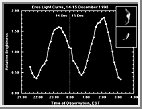|
COMETS EARTH JUPITER KUIPER BELT MARS MERCURY METEORITES NEPTUNE OORT CLOUD PLUTO SATURN SOLAR SYSTEM SPACE SUN URANUS VENUS ORDER PRINTS
PHOTO CATEGORIES SCIENCEVIEWS AMERICAN INDIAN AMPHIBIANS BIRDS BUGS FINE ART FOSSILS THE ISLANDS HISTORICAL PHOTOS MAMMALS OTHER PARKS PLANTS RELIGIOUS REPTILES SCIENCEVIEWS PRINTS
|
Related Document
Download Options
Brightness variations of the asteroid Eros were measured by the multispectral imager on the Near Earth Asteroid Rendezvous (NEAR) spacecraft on December 14-15, 1998, as the spacecraft was closing on the asteroid at a distance of 460,000 miles (740,000 kilometers). The time period of the measurements covers just over one rotation of the asteroid, which takes 5 hours, 17 minutes. At the time of the measurements, Eros still appeared smaller than one pixel in size, so its shape was not resolvable. The large variations in apparent brightness of Eros result from the elongated shape of the asteroid. The two inset images, which were acquired as NEAR passed the asteroid on December 23, show the approximate orientation of the asteroid at the points of maximum brightness (top) and minimum brightness (bottom). NEAR's main engine was fired successfully on January 3, 1999, placing NEAR on-course for a February 2000 rendezvous with Eros. Eros is NEAR's second asteroid encountered. On June 27, 1997, NEAR flew by the main-belt asteroid Mathilde at a range of 1212 kilometers |
